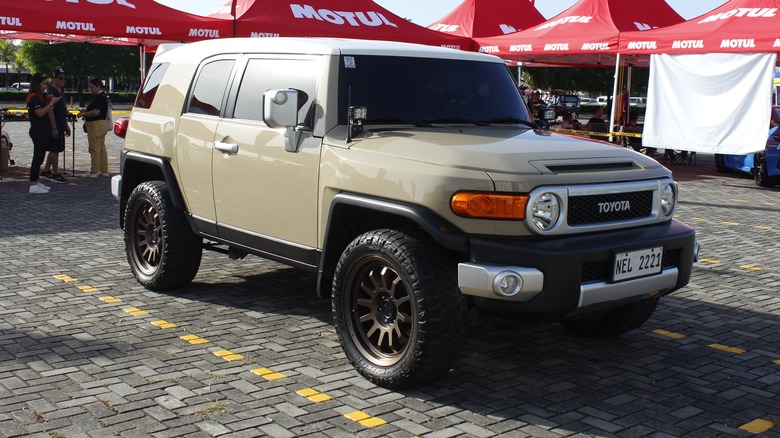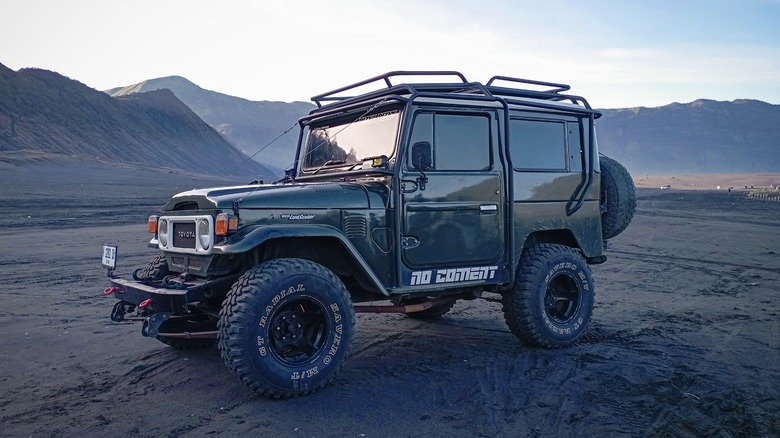Toyota FJ Cruiser: What Does The Acronym Stand For?
The Toyota FJ Cruiser is one of Toyota's most recognizable mid-size SUVs, thanks to its quirky, retro look. The car debuted at the 2003 Chicago Auto Show as a retro concept vehicle with styling cues derived from Toyota's legendary Land Cruiser FJ40. Following an overwhelmingly positive response to the concept, Toyota decided to produce the FJ Cruiser, with the first of these cars arriving in the U.S. market in 2006.
The FJ Cruiser was an immediate success in the U.S., with first-year sales exceeding 56,000 units. The car continued to sell decently for the next few years, although numbers steadily declined. By 2013, poor sales led Toyota to discontinue the vehicle in the U.S. Toyota continued to sell the FJ Cruiser in other markets, such as the Middle East and some Southeast Asian countries, for several more years before discontinuing it worldwide in 2023. Throughout the FJ Cruiser's production run, Toyota never explained what "FJ" stood for, leading fans to come up with their own interpretations, ranging from playful to sarcastic.
As it turns out, the "FJ" in the original FJ40 wasn't just a random set of letters. The "F" referred to Toyota's F-series engine used in some of Toyota's most iconic pickup trucks, while the "J" stood for Jeep, denoting the vehicle's off-road, 4x4 utility design. Similarly, the BJ40, its predecessor, used Toyota's B-series diesel engine, with the same "J" signifying a Jeep-style vehicle. In the case of the FJ Cruiser, however, the name doesn't reflect the engine or drivetrain. Instead, it's a nostalgic tribute to the legendary FJ-series Land Cruisers — honoring their rugged legacy while packaging it in a modern, retro-inspired design.
The Toyota Land Cruiser and the Jeep connection
Today, Jeep is owned by the Stellantis Group alongside brands like Alfa Romeo, Chrysler, Dodge, and Ram. Older auto enthusiasts will know that long before becoming an automobile brand, the word "Jeep" referred to a specific category of off-road vehicles. The most popular among these was the Willys Jeep MB, which is often referred to as the ultimate off-road machine. The success of the Willys Jeep MB and the Ford-built Jeep GPW prompted Toyota to come up with its version of the Jeep.
There's a story about how Japan — and Toyota — first encountered the Jeep. In 1944, during the invasion of the Philippines, Japanese forces came across an abandoned American Jeep. Impressed by its capabilities, they shipped it back to Japan and tasked Toyota with developing a similar vehicle. This led to the creation of several early prototypes, including the Toyota AK10.
Fast forward to 1950 and the Korean War. The U.S., which still occupied Japan, asked Japanese companies to build 4WD vehicles for the South Korean military. Toyota submitted a new Jeep-style prototype to the Japanese National Police Reserve. However, it was ultimately rejected in favor of a licensed Willys Jeep produced by Toyota's rival, Mitsubishi.
Despite the rejection, Toyota's interest in rugged, compact Jeep-type vehicles never died. The company continued further refining the platform, resulting in the development of the Toyota Jeep BJ in 1951. The growing popularity of the Jeep eventually resulted in Willys trademarking the Jeep name. Following this, Toyota decided to rename its Jeeps to "Land Cruiser." This marked the birth of the now-famous Land Cruiser series with the Land Cruiser FJ40, which eventually spawned the Toyota FJ Cruiser.

